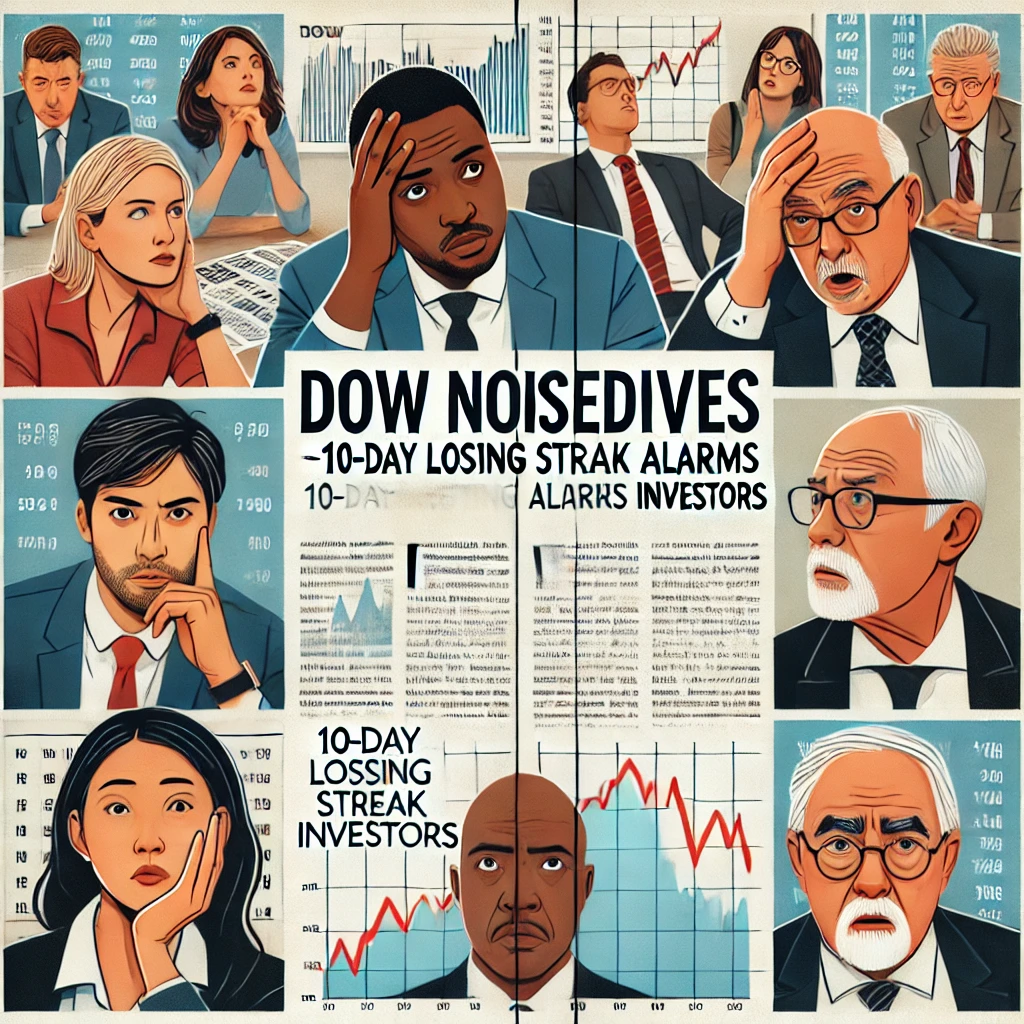Understanding the Dow’s Downfall:
Much of the recent nosedive is due to the most recent projections from the Federal Reserve that predicted fewer interest rate cuts than the market was expecting. Investors still grapple with the fact that much higher borrowing costs and tighter financial conditions are going to weigh on equities in a world that has had to shift on the fly to a monetary policy tightening paradigm that was a surprise to many.
Investor Sentiment and Market Reaction:
Wall Street has become pretty quick. And with the Dow’s extended losing streak, investors are rethinking where they stand in a rising climate of uncertainty over what the global economy will look like. Anxiety is sending trading volumes flying, and traders are hedging against further volatility by moving their strategies around.
Sector impact and broader implications:
Both sensitive to swings in economic forecasts and interest rates, technology and industrial companies have been the hardest hit. But sectors like utilities and consumer staples have proved relatively resistant, though not by enough to make up for it at the market indices level.
Expert Analysis and Future Projections:
That’s why financial analysts are warning that the indices are more likely to continue to fluctuate. Market strategist notes that an early sign of a bigger correction to come… The stock market reacts to short-term and not-long-term: ‘you should think about diversifying your portfolio and investing long-term, not short-term.’.
Strategies for Navigating Market Uncertainties:
In these turbulent times, experts recommend a balanced investment approach:
- Diversification: It also demonstrates why we recommend spreading investments across different asset classes to allocate risk to tolerate uncertainty.
- Quality Over Quantity: However, if you decide to invest, then emphasise stocks with good fundamentals (top-tier earnings growth, stable debt levels).
- Stay Informed: Always stay up to date with global economic indicators and central bank announcements, which are big guns that must disrupt your market equations.
Conclusion:
After all, it only takes 10 days for the Dow to tumble when there are no certainties in the stock markets. Additional layers of complexity and uncertainty will also undermine the ability of companies to make the strategic, evidence-informed investment choices required to navigate this landscape in the nearer term. In these uncertain times, we advise investors to vigilantly and proactively manage their portfolios.
Keywords: The stock market crash, Dow Jones, interest rate cuts, investor sentiment, Federal Reserve, investment strategies, market volatility
This article explores the reasons behind the recent selloffs of the Dow and gives investment guidance to investors navigating through this volatile market.
Immediate Causes of the Dow’s Decline:
Latest Fed announcement is one of the major catalysts behind the Dow’s huge drop as the announcement came through to be more cautious with future interest rate cuts than was previously thought. Ambitions for more aggressive rate reductions aimed at helping combat slowing economic growth were for less than investors hoped. In terms of the Fed’s side, we’ve seen what they are basically taking a mildly inflation and economy conservative approach, and we have seen a cascade hallmark selling off on almost all major indexes.
Impact on Investor Sentiment and Market Behaviour:
The Dow’shows all these losses’ as investors become increasingly uncertain. Certainly the mood has changed, as the market is really thinking about what the Fed’s policies mean. Perhaps the less a country depends on monetary policy as a buffer to economic downturns, the more it transforms the risk of holding equities into a problem that investors have to think about. In addition, it comes amidst global economic uncertainty, including trade tensions and geopolitical instabilities.

Sector-Specific Reactions:
There have been different reactions of different sectors from the recent downturn. Traditionally, drops in technology and consumer discretionary sectors were sensitive to economic expectations. At the same time, utilities and consumer staples in a volatile world have been steadier bets. 这种对市场难以抗预测的投资,有点谨慎的谋宣是目前市场常冲诸此态而被衡所指称的许多投资人可能没想到市场的波动是总会有确定的。
Long-Term Outlook for the Dow and Global Markets:
We’ll never see a signal that the Dow or broader markets are on a trajectory for more gains. Much depends on data, government policy approaches, and the state of global economies, analysts said. Markets may thrash about through these choppy waters, making investors face more volatility. We also see room for a revaluing of asset values, which suggests a role for thoughtful investors that invest in what they know, not what’s mispriced.
Conclusion:
Stock markets are fragile things, as we’ve witnessed recently with the plunge in the Dow when monetary policy switched and uncertainty on the rise. Such examples for these investors can encourage them not to fall back this time into the market déjà vu and should add diversification as well as education on macrodevelopment of the world economy. Now it might be dark today and potentially tomorrow, but the fundamentals remain: the fundamentals of sound analysis and strategic investing are what will ultimately get you through future market cycles.

Keywords: The viewpoint of Dow Jones in the stock market, Federal Reserve, interest rates, economic growth, investor sentiment, market volatility, sector performance.
Second, none of Dow’s recent dip should be anything to worry about, but I dive into this by doing an in-depth analysis of the market through more general economic indicators to show you what this actually means for the whole market in general.
FAQ: To What Extent Does The 10-Day Losing Streak In The Dow Affect YOU?
Q: What made them dump the Dow so much?
- Ans: The Federal Reserve projection of fewer interest rate cuts than market anticipated** was the primary reason for Dow’s 1,100 point drop. Investor sentiment was affected by a major sell-off.
Q: How does the stock market react to the Federal Reserve’s decision?
- Ans: The movement of the stock market can be greatly affected by interest rates at the Federal Reserve. Usually, when interest rates are lower, people go out and borrow and invest and push up the price of stocks. That would be associated with lower investment and lower stock prices, fewer rate cuts to come.
Q: Which sectors were hit hardest by Dow’s decline?
- Ans:Economic outlook changed as did expectations for interest rates and this hurt the technology and industrial sectors. In the majority cases, these sectors change with the change in economy and policy changes.
Q: What do investors do in times like these?
- But most experts also suggest spreading your investments among various asset classes and sticking to the global economic indicators while choosing qualitative stocks whose quality is likely to continue to rise. Also, the market should not react in the short term because all market developments should be done through long-term financial goal.
Q: How do you think the Dow and the overall market are looking?
- A: Some remain doubtful about how long volatility is expected to last. A great deal from here will depend on what economic data is coming out in the near term, what happens to the economy globally, and what the government will do. Investors have to be ready for that.
Q: What do investors do to reduce risk in an unstable market?
- Then, there’s the additional danger that necessitates that you diversify your portfolio, put your money into the stable sector of utilities and consumer stamps, and finally add in a balance between stock and bond. Still, it is necessary to follow market trends and economic news.
Q: What can I learn about managing investments if the market is going down?
- Ans: That said, there are simple means by which you can engage with financial advisors, review or read worthy financial news sources, or invest platforms for general instructional content. However, they also supply webinars, articles, and tools to help you understand market workings or strategies to diversify your investment.




